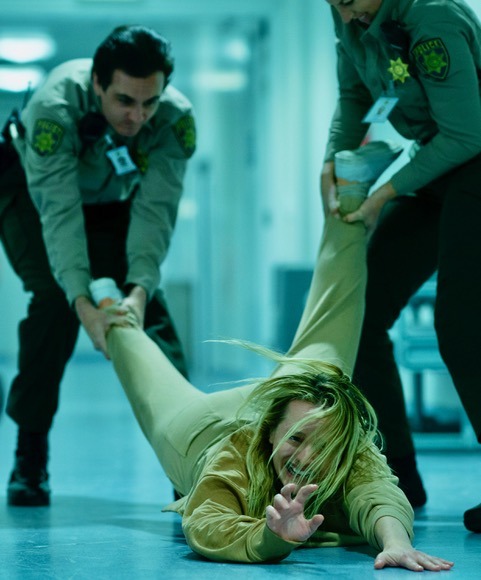[ad_1]
By Dwight Brown
NNPA News Wire Film Critic
An old concept isn’t getting a noteworthy update and that problem doesn’t go away.
The Invisible Man is a mainstay in the movie world, with origins dating back to the 1897 novel by H.G. Wells. A scientist with a focus on optics finds a way to change human refractive matter into thin air. He disappears, can’t reverse the process and causes mayhem.
The 1933 film The Invisible Man, starring Claude Rains, mined that premise. Other movies with diverse approaches followed: 1992’s Memoirs of an Invisible Man, a comedy starring Chevy Chase and 2007’s The Invisible, a crime drama; most centered around the man with the Saran Wrap complexion. This latest chapter, instead, concentrates on a victim. It’s a mistake.

Cecilia Kass (Elisabeth Moss, The Handmaid’s Tale), an abused woman, escapes from her very wealthy and controlling lover Adrian (Oliver Jackson-Cohen, Netflix’s The Haunting of Hill House), an optics scientist. She flees in the dead of night. Her sister Emily (Harriet Dyer, NBC’s The InBetween) drives the getaway car. Her childhood friend James (Aldis Hodge, Brian Banks), a cop, along with his teenage daughter Sydney (Storm Reid, HBO’s Euphoria) make their home her refuge.
Cecilia finds out Adrian has committed suicide. His brother Tom (Michael Dorman), the executor of his estate, says his sibling left her lots of money in a trust fund. But something doesn’t feel right. It’s like Adrian still has control over her, even from the grave. Then weird, inexplicable things start to happen.

The setup for this suspense/sci-fi/thriller is pretty good. When it magnifies the main character’s psychological torture, it excels. Cecilia has severe mental problems that only Diazepam, a powerful benzodiazepine drug that affects chemicals in the brain, can stabilize. She’s a vulnerable protagonist haunted and hunted, you have to feel for her. Adrian is a narcissistic, sadistic, domineering and sociopathic scientist. Can’t think of a more worthy antagonist.
If writer/director Leigh Whannell (Upgrade and Insidious: Chapter 3) had left well enough alone, and concentrated on the mind-game horror that drives Cecilia batty and alienates her from her family and friends, that heightened state of anxiety would have worked your nerves for 1h 50min. She’s arrested, incarcerated and estranged. You empathize. And not knowing definitively what’s messing with her mind—mental illness or her man—is even more torturous.

The film falters when it ventures into sci-fi. The effects that make Adrian invisible are never seen in a transitional phase. We have an inkling, and of course the film’s title is a dead giveaway. But real evidence only shows up deep into the footage. Dude looks like a vapor. We have to deal with an invisible man who is not all that interesting to watch (footprints) or follow (we’ve never seen the origin of his metamorphosis). And we never get to know him, witness his high-tech skills or uncover his motivation. He’s never the focus.
Sound effects supervisor Dan Oliver (Mad Max: Fury Road) does a fantastic job assaulting your eardrums. Clever opening credits depict strong waves pounding up against a rocky shoreline making noises as loud as cannon shots. Jolting sounds become a key part of the film’s creepy aura.

Video effects supervisor Jonathan Dearing (Upgrade) is far less successful at scaring the b’jezus out of you. His idea of sci-fi magic for his invisible man is just plain lame. If this is a real science fiction movie, uncanny sci-fi wizardry should be its hallmark. What we see, or don’t see, would be laughed out of a Comic Con convention.
Leigh Whannell, who was the writer and co-star of the first Saw movie, doesn’t have one original gimmick in his trick bag. Nothing. Scenes drag on (editor Andy Canny, Upgrade) long after their point has been made. There’s lots of dread and not enough scares.
His best direction involves a scene in a hospital where two cops are dragging poor Cecilia down a hall, by her feet. As she claws the gray cement floor, screaming and yelling for her life and putting up a concerted resistance, the camera catches Moss’ face in complete panic mode. Wow. Still, this was an opportunity for Whannell, as a director, to put his own style and imprint on a movie. He balks.
Whannell is better with the script. Like it or not, it has a strong beginning, a weaker middle and an end that doesn’t’ live up to expectations. He’s more skillful with the dialogue: Cecilia in the most traumatized voice: “He said he would walk right up to me. I wouldn’t see him. But he’d be there!” Adrian spewing the worst threat anyone could give: “I’m going to hurt someone you love.”
Interior and exterior shots look decent and are well lit (cinematographer Stefan Duscio, Upgrade). The ultra modern sets at Adrian’s swank abode fit his cold personality. Conversely, the homespun furniture at James’ home augment his folksy persona (production designer Alex Holmes, The Babadook). And everyone seems to be wearing the right clothes, from doctors, to restaurant patrons to the cops (costume designer Emily Seresin, Top of the Lake).
It’s hard to take your eyes off Elisabeth Moss. She pulls you into her character’s distress. Her efforts are even more noticeable in a generic film where her big talent overshadows puny direction. When Cecilia is scared, you’re terrified. New Zealand actor Michael Dorman, who plays Adrian’s duplicitous brother, gives a layered and demented performance that is far more interesting to watch than Oliver Jackson-Cohen as Adrian. That’s a casting choice that should have been reversed.
Dyer is solid as the helpful sister. Storm Reid excels as the friendly daughter. Aldis Hodge is building quite the resume: Straight Outta Compton, Clemency, Hidden Figures. He’s becoming that go-to actor with an everyman quality that never gets tired. You can’t buy that. You have it or you don’t.
If the weakest part of a suspense/sci-fi/thriller is the science fiction elements, we’re all in a world of trouble.
Visit NNPA News Wire Film Critic Dwight Brown at DwightBrownInk.com and BlackPressUSA.com.
[ad_2]
Source link
